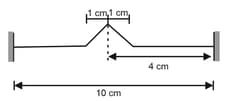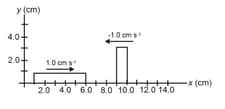A thin taut string tied at both ends and oscillating in its third harmonic has its shape described by the equation , where the origin is at the left end of the string, the -axis is along the string and the -axis is perpendicular to the string.
(a) Draw a sketch that shows the standing wave pattern.
(b) Find the amplitude of the two travelling waves that make up this standing wave.
(c) What is the length of the string?
(d) Find the wavelength, frequency, period and speed of the travelling wave.
(e) Find the maximum transverse speed of a point on the string.
(f) What would be the equation for this string if it were vibrating in its eighth harmonic?

Important Questions on Superposition of Waves
(a) What is the speed of propagation of transverse wave in the wire?
(b) Compute the tension in the wire.
(c) Find the maximum transverse velocity and acceleration of particles in the wire.
and
(a) Write the expression for the sum for .
(b) Suppose the phase difference between the waves is unknown and the amplitude of their sum is , what is ?
Figure shows different standing wave patterns on a string of linear mass density under a tension of . The amplitude of antinodes is indicated in each figure. The length of the string is .
(i) Obtain the frequencies of the modes shown in figures and .
(ii) Write down the transverse displacement as a function of and for each mode. (Take the initial configuration of the wire in each mode to be as shown by the dark lines in the figure).
(a) What are the wavelengths of the fundamental and the first two overtones?
(b) What are the frequencies of these standing waves?
[Note: In this case, fixed end is a node and the end tied with the light string is antinode.]
(a) Which harmonics are these?
(b) What is the length of the string?
(c) What is the wavelength of the fundamental frequency?
A wave is travelling along a string toward a boundary at . Write expressions for the reflected waves if
(a) the string has a fixed end at and
(b) the string has a free end at
Assume SI units.
A string that is long is fixed at both ends. At , a pulse traveling from left to right at is from the right end as shown in figure. Determine the next two times when the pulse will be at that point again. State in each case whether the pulse is upright or inverted.
Two pulses travelling in opposite directions along a string are shown for in the figure. Plot the shape of the string at and , respectively.



